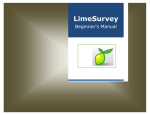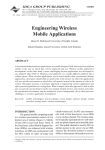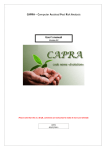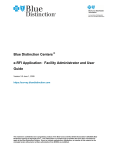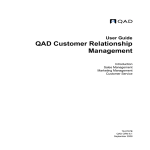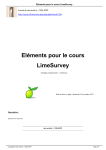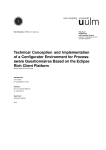Download LimeSurvey Quick Start Guide: Version 1.5
Transcript
LimeSurvey Quick Start Guide: Version 1.5 Computing and Communications Services (CCS) - LimeSurvey Quick Start Guide Version 1.5 1 Table of Contents Contents Table of Contents .......................................................................................................................................... 2 Introduction: ................................................................................................................................................ 3 1. About Your LimeSurvey Account: .......................................................................................................... 5 1.1 How do I get a LimeSurvey account? .................................................................................................. 5 1.2 How do I log in to LimeSurvey?........................................................................................................... 5 1.3 How do I change my LimeSurvey account’s password? ..................................................................... 7 1.4 Where is my survey data stored? ...................................................................................................... 9 1.5 How long is my survey data kept? ..................................................................................................... 9 1.6 How can I get an overview of all my account’s surveys in LimeSurvey? ........................................... 9 1.7 How can colleagues on my research team work on the survey’ s development with me? ............ 10 1.8 Where can I get help with LimeSurvey?........................................................................................... 11 1.9 What are the known issues with LimeSurvey? ................................................................................ 12 2. Navigating within LimeSurvey: ............................................................................................................ 13 3. How to create a first survey:................................................................................................................. 17 Step 1 - Create a New Survey.................................................................................................................. 20 Step 2 - Create Question Groups ............................................................................................................ 25 Step 3 - Create Questions ....................................................................................................................... 28 Step 4 – Activate Your Survey ................................................................................................................. 40 Step 5 – Announce Your Survey .............................................................................................................. 45 Step 6 – View and optionally export your survey response data. .......................................................... 48 Step 7 – Close your survey after its completion. .................................................................................... 50 4. To Learn more: ...................................................................................................................................... 56 5. Give us your feedback: .......................................................................................................................... 56 Computing and Communications Services (CCS) - LimeSurvey Quick Start Guide Version 1.5 2 Introduction: LimeSurvey is a web application that enables members of the University of Guelph / GuelphHumber community to create, manage and deploy an unlimited number of online surveys. You can create, deploy and manage your survey via the web - no desktop software is required beyond a web browser and an internet connection. Once activated, your survey can be completed by anyone on the Internet, or it can be restricted to a defined group of users (known as a "panel"). Surveys can be created from scratch or imported and subsequently modified from other LimeSurvey surveys. You can view your survey responses, and generate basic frequency counts of replies, with tools within LimeSurvey. In addition you can export your survey results to products like Microsoft Excel or SPSS for more indepth analysis and reporting. As the survey’s administrator, you can grant various rights to your survey to colleagues who also have LimeSurvey accounts. For example you can grant a colleague the right to browse responses to your survey, and grant another colleague the right to edit your survey’s questions. LimeSurvey is supported by Computing and Communications Services (CCS) – please contact us if you need assistance. You can reach us by sending email to [email protected] This guide shows you how to create a first survey with LimeSurvey, the CCS-supported product for online surveys. Some material in section 3 of this guide was adapted from a guide developed by Steve Pallett at the University of Ballarat, Australia. CCS extends our appreciation to Mr. Pallett for permission to use his guide as a basis for this material. The complete user guide for LimeSurvey is available here. The URL is: http://docs.limesurvey.org/tiki-index.php?page=English+Instructions+for+LimeSurvey When viewing the user guide start with the Creating surveys – Introduction section. The content before this section is only relevant for computer system administrators who wish to install their own version of LimeSurvey on a web server. Figure i below shows the opening page of the LimeSurvey user guide and indicates where you should start in the table of contents. Computing and Communications Services (CCS) - LimeSurvey Quick Start Guide Version 1.5 3 Figure i: The opening page of the LimeSurvey User Guide. The URL for the guide is: http://docs.limesurvey.org/tiki-index.php?page=English+Instructions+for+LimeSurvey Computing and Communications Services (CCS) - LimeSurvey Quick Start Guide Version 1.5 4 1. About Your LimeSurvey Account: 1.1 How do I get a LimeSurvey account? A LimeSurvey account is required to administer surveys in the LimeSurvey system. An account consists of a Username and associated Password. There is no charge for a LimeSurvey account for members of the University of Guelph / Guelph-Humber community. To request an account please send email to [email protected] Accounts are normally available within 2-3 business days of their request. Once your account has been created, you will receive an automated email message from the LimeSurvey system with your Username and Password. The email message will also contain the link you click to login to LimeSurvey. There is no limit to the number of surveys you can create, or responses you can collect with your account. 1.2 How do I log in to LimeSurvey? You log in to LimeSurvey by clicking on the Login to LimeSurvey link on the CCS product page for LimeSurvey at http://www.uoguelph.ca/ccs/software/supported-products/limesurvey (see the location pointed to by the red arrow in Figure I below). Besides containing the link to login to LimeSurvey the web page contains additional information and resources related to online surveys in general and LimeSurvey in particular. For example, you will find a link to: the latest version of this Quick Start Guide, a number of LimeSurvey Drill Down Guides that provide detailed “how to” information for specific uses of LimeSurvey such as for online voting / elections, various “best practices” articles related to online surveys. Computing and Communications Services (CCS) - LimeSurvey Quick Start Guide Version 1.5 5 Figure I: The CCS web page for LimeSurvey, showing the link you click to login to LimeSurvey (pointed to by the red arrow). Clicking the login to LimeSurvey link on the above web page will bring you to the LimeSurvey login page shown in Figure II below. Enter your LimeSurvey Username and Password and then click the Login button (pointed to by red arrow 1 in Figure II below). Note the area pointed to Computing and Communications Services (CCS) - LimeSurvey Quick Start Guide Version 1.5 6 by red arrow 2 in Figure II. This area is used to display current information about the service. Figure II: The LimeSurvey login page. 1.3 How do I change my LimeSurvey account’s password? After you login to LimeSurvey you can change your password by following these three steps. 1. Click the ‘Key’ icon on the Administration toolbar. The location of this icon is pointed to by the red arrow in Figure 1 below. (Note that a “tooltip” is displayed when you mouse over any icon in LimeSurvey. The tooltip summarizes the action of the icon. The tooltip for the ‘Key’ icon is visible in Figure 1, to the right of the red arrow, and reads: Create/edit users). Computing and Communications Services (CCS) - LimeSurvey Quick Start Guide Version 1.5 7 Figure 1: The location of the ‘Key’ icon on the Administration toolbar. 2. Find your Username in the resulting list. Click the ‘Pencil’ icon beside your username. (Only your Username will have the Pencil icon beside it). (Note: the pencil icon is used throughout LimeSurvey to let you edit various content). Figure 2: Your LimeSurvey Username will have a Pencil icon beside it indicating you may edit information about this account. Click the pencil icon to access the information. 3. Clicking the ‘Pencil’ icon will display the form shown in Figure 3 below. Update the form’s fields with any changes you wish to make, such as your Password, then click the Save button. You can change the email address, full name, and password associated with your LimeSurvey account. Computing and Communications Services (CCS) - LimeSurvey Quick Start Guide Version 1.5 8 Figure 3: Information you can change about your account is displayed. Ensure you click the Save button after making changes to update your account. 1.4 Where is my survey data stored? Your survey data is stored in the CCS data centre at the University of Guelph. The data centre is a secure facility with access restricted to authorized personnel only. All traffic between your web browser and the LimeSurvey web server is SSL encrypted. Similarly, all traffic between your survey respondents’ web browsers and the LimeSurvey web server is also SSL encrypted. CCS strictly adheres to the University of Guelph’s policies governing the privacy and protection of personal information. 1.5 How long is my survey data kept? Survey data is stored for two years. To keep your data beyond this time period you can export your responses to Excel, SPSS, etc. 1.6 How can I get an overview of all my account’s surveys in LimeSurvey? Click the “List surveys” icon on the Administrative toolbar (the icon is pointed to by the red arrow in Figure 3A below). A summary of all your account’s surveys will be displayed as illustrated in Figure 3B below. Note that clicking on a survey’s name in the list will let you access that survey for editing, reviewing responses, etc. You can also access a survey by selecting it from the drop-down list pointed to by the red arrow in Figure 3B. Computing and Communications Services (CCS) - LimeSurvey Quick Start Guide Version 1.5 9 Figure 3A: The location of the List surveys icon on the Administration toolbar. Figure 3B: The display summarizing all your account’s surveys. Clicking on any survey’s name will let you access it for editing, reviewing responses, etc. You can also access a survey by selecting it from the drop down list pointed to by the red arrow in this Figure. 1.7 How can colleagues on my research team work on the survey’ s development with me? As the survey owner (i.e. the “survey administrator” in LimeSurvey terminology) you can assign various rights to the survey to colleagues who also have LimeSurvey accounts in the University of Guelph LimeSurvey system. For example you can grant a colleague “editing” rights to your Computing and Communications Services (CCS) - LimeSurvey Quick Start Guide Version 1.5 10 survey so they can make changes to your survey’s questions, answer choices, metadata, etc., and grant another colleague “view response” rights so they can view responses to your survey as they are submitted. Please refer to the LimeSurvey Drill Down Document: How to grant rights to your survey to another LimeSurvey user for more information. The document is available on the CCS webpage for LimeSurvey here: http://www.uoguelph.ca/ccs/software/supported-products/limesurvey 1.8 Where can I get help with LimeSurvey? You can get assistance in three ways: 1. Official LimeSurvey documentation The URL is: http://docs.limesurvey.org/tiki-index.php?page=English+Instructions+for+LimeSurvey Start with the Creating Surveys - Introduction section. The content above this section relates to computer system administrators wishing to install their own instance of LimeSurvey on a server. 2. Quick Start Guide and Drill-Down Guides on the CCS website. The URL for the web page is: http://www.uoguelph.ca/ccs/software/supported-products/limesurvey Please review the above web page on the CCS website for the latest copy of this Quick Start Guide. In addition CCS has prepared a number of Drill-Down Guides that cover specific topics related to LimeSurvey. You will find these Drill-Down Guides in the User guides to help you use LimeSurvey section of the webpage. 3. Contact a survey support analyst. LimeSurvey is supported by staff in the University of Guelph Library’s Data Resource Centre (DRC). The DRC is a joint initiative between Computing and Communications Services (CCS) and the University of Guelph Library. If you need assistance with LimeSurvey, please contact us by sending email to the Data Resource Centre: [email protected] Computing and Communications Services (CCS) - LimeSurvey Quick Start Guide Version 1.5 11 1.9 What are the known issues with LimeSurvey? Current information on the known issues with LimeSurvey is maintained on the CCS website. The URL for the web page is: http://www.uoguelph.ca/ccs/software/supported-products/limesurvey Please review the section: Essential Points you need to be aware of on the web page regularly for the latest information on issues, service updates, etc. Updates to this area of the web page will be flagged via a news headline item in the area of the LimeSurvey login page pointed to by red arrow 2 in Figure II above. Please review this section of the CCS LimeSurvey web page regularly for information you need to be aware of. The URL for this page is: http://www.uoguelph.ca/ccs/software/supported-products/limesurvey Computing and Communications Services (CCS) - LimeSurvey Quick Start Guide Version 1.5 12 2. Navigating within LimeSurvey: 1. Toolbars, tooltips, icons, and drop-down lists. When you first login to LimeSurvey you will be presented with the Administration toolbar as shown in Figure A below. Note that LimeSurvey toolbars contain various icons displayed from left to right across the toolbar. Place you mouse over any icon and a tooltip will be displayed that summarizes the action of that specific icon. In Figure A, the Administration toolbar is outlined with a red rectangle. An icon on the toolbar is pointed to by red arrow 1. The resulting tooltip displayed when you mouse over the icon is pointed to by red arrow 2. As well as containing icons, many toolbars contain drop-down lists of choices you can make selections from. These drop-down lists are always on the toolbar’s right side. Red arrow 3 in Figure A points to an example drop down list. On the Administration toolbar the drop-down list contains the list of surveys associated with your account. You can select the survey you wish to work with by clicking on its name in the list. Figure A: The Administration toolbar. This is the only toolbar displayed when you login to LimeSurvey. Subsequent toolbars appear as you work with LimeSurvey’s features. As you work with LimeSurvey additional toolbars frequently appear as illustrated in Figure B below. The toolbars cascade one beneath another down the web page. Note that each toolbar’s name is displayed in its upper left corner. In Figure B below, four toolbars are shown: the Administration, Survey, Question group and Question toolbars. The location of the toolbar’s names is outlined with red rectangles in Figure B. Computing and Communications Services (CCS) - LimeSurvey Quick Start Guide Version 1.5 13 Figure B: Additional toolbars frequently appear, and they are presented (i.e. cascade) one beneath the other down the page. This figure shows four toolbars – their names are circled in red. 2. Forms. Often when you click on a toolbar’s icon you are presented with a form that you complete to supply specific information. The form is always displayed beneath the lowest toolbar on your webpage. After completing the desired areas of the form be sure to click its associated Save button to save your input. The form’s associated Save button always appears at the bottom of the form. Figure C below illustrates the form that appears when you click the ‘Add new group to survey’ icon on the Survey toolbar. The icon is pointed to by red arrow 1. Clicking this icon is what caused the form to be displayed. Note how the form is displayed beneath the lowest toolbar. Computing and Communications Services (CCS) - LimeSurvey Quick Start Guide Version 1.5 14 Figure C: The form that appears when you click the ‘Add new group to survey’ icon on the Survey toolbar. Remember to click the form’s associated Save button to save your input. Computing and Communications Services (CCS) - LimeSurvey Quick Start Guide Version 1.5 15 3. Toolbar Reduction. Some icons when clicked replace all the cascaded toolbars with just one toolbar. This is done to provide more space in the “form” area beneath the toolbar. When this happens, you can click the ‘Return to survey administration’ icon on the singly-displayed toolbar to return to the previous multiple-toolbar display. The ‘Return to survey administration’ icon looks like a house and is pointed to by the red arrow in Figure D below. Figure D: You can click the ‘Return to survey administration’ icon to return to a previous multiple-toolbar display. 4. Logging out. When you have finished working with LimeSurvey you logout by clicking the ‘Logout’ icon on the Administration toolbar. The icon is pointed to by the red arrow in Figure E below. Clicking this Logout icon ensures your session completes properly. Figure E: The location of the Logout icon on the Administration toolbar. Please ensure you logout after completing your LimeSurvey session. Computing and Communications Services (CCS) - LimeSurvey Quick Start Guide Version 1.5 16 3. How to create a first survey: The components of a survey in the LimeSurvey system. Before creating your first survey it is helpful to understand the three main components that make up a survey in the LimeSurvey system. These components are illustrated in Figure H below. The three components are: 1. The Survey container (outlined in red in Figure H). This is the “box” that holds all the various pieces of your survey and the metadata that describes things such as how the survey should be presented. The Survey container is usually just referred to as the Survey. You give your survey a Title, and the Title is how you distinguish one survey from another in your LimeSurvey account. You can have numerous surveys in your account. You configure your survey’s metadata to control such things as whether your survey is publically available or requires a password, when it should open and close, what template (i.e. colour scheme) it should use, etc. 2. Question Groups (there are three such groups shown in Figure H – they are outlined in blue). Question Groups are the “boxes” within your survey that hold questions. A survey must contain at least one Question Group. Often you put similar questions into the same Question Group. For example questions related to demographics such as Gender, Age, Location, etc. could all be placed in the same Question Group. A second Question Group could be used to hold questions on, say, the respondent’s retail shopping habits, and a third Question Group could be used to hold questions on, say, the respondent’s recreational activities. Often you configure your survey’s metadata so that all the questions in a Question Group are displayed on the same page to your respondent – as the respondent proceeds from page to page in your survey what they see are the questions in that page’s Question Group. 3. Questions (there are nine questions shown in Figure H). These are the actual questions you wish to present to the respondent. LimeSurvey has a wide range of question types you can choose from as documented in the LimeSurvey User Manual here. When a respondent accesses your survey LimeSurvey will present the questions in the order shown by the green arrow in Figure H. i.e. It will start with the first question in the first Question Group and proceed linearly through to the last question in the last question group. You can assign “conditions” to questions to provide control over whether a question will or will not be shown depending on the respondent’s answers to earlier questions in the survey. Computing and Communications Services (CCS) - LimeSurvey Quick Start Guide Version 1.5 17 Figure H: Illustrating the three main components of a survey in the LimeSurvey system: (1) the Survey Container, (2) Question Groups, and (3) Questions. Order of display to your respondents Question 1 Question Group Survey Question 2 Container Question 3 Question 4 Question 5 Question 6 Question 7 Question Group Question Group Question 8 Question 9 Question Computing and Communications Services (CCS) - LimeSurvey Quick Start Guide Version 1.5 18 The seven steps to create a survey. There are seven steps to creating a basic survey in the LimeSurvey system. Each of the seven steps is explained next in this guide. Step 1: Create a new survey and enter general details about it. i.e. Create the Survey Container as illustrated in Figure H. The "general details" may be thought of as the survey's metadata. (e.g. your survey's: title, welcome text, description text, activation date, expiration date, template for the colour scheme and images, access mode (public or restricted to members of a panel), the web page to be loaded after the respondent submits their responses, etc.). Step 2: Create at least one 'Question group' to contain your questions. A ‘Question group’ in LimeSurvey is a container to hold questions and is also known as a ‘block’ or a ‘page’ in other online survey tools. All questions in LimeSurvey must belong to a Question group. You can place related questions in their own Question groups to help organize your survey if desired. In your survey’s metadata you can specify that your survey should be presented one question at a time, or Question group by Question group. Step 3: Create questions and any associated subquestions and answers. After you have completed Step 3 you will have the pieces shown in Figure H. Step 4: Test and activate your survey. Step 5: Announce your survey to intended respondents. Step 6: View and optionally export your survey response data. Step 7: Close your survey after its completion. Computing and Communications Services (CCS) - LimeSurvey Quick Start Guide Version 1.5 19 Step 1 - Create a New Survey 1. Click the 'Create, import or copy a survey' icon on the administration toolbar. The location of the icon is pointed to by the red arrow in Figure 4 below. TIP: Whenever you scroll over an icon in LimeSurvey, the icon’s function appears as a pop-up message or tooltip hi-lighted in yellow. Figure 4 shows the tooltip that is displayed when you position your mouse over the ‘Create, import or copy a survey’ icon. Figure 4: The location of the ‘Create, import or copy a survey’ icon on the Administration Toolbar. Computing and Communications Services (CCS) - LimeSurvey Quick Start Guide Version 1.5 20 2. You will then be presented with a new screen containing several tabs as illustrated in Figure 5 below. This is where you enter the general details (i.e. your survey's metadata) about your survey, such as the welcome message users see on your survey's opening page. You can edit these metadata details later, right up to the point where your survey is deployed (and some metadata components can be changed even when your survey is active). Click on each tab to enter, review or edit its associated metadata information. If you are not importing a survey you can ignore the 'Import' tab. When creating a survey, you only need enter its Title and Language as a starting point. You can return to the survey’s metadata, to make modifications to the various other metadata components, later if desired. Figure 5 illustrates the metadata contents on the “General” tab. CCS has prepared a LimeSurvey Drill Down Guide that provides more information about what the metadata settings on the other tabs are for. The document is available on the CCS LimeSurvey web page here. The URL for the web page is: http://www.uoguelph.ca/ccs/software/supported-products/limesurvey TIP: remember that in LimeSurvey you specify specific content by completing the form fields that appear beneath the lowest toolbar. Ensure you click the form’s associated Save button to save your specifications. Figure 5: The tabs containing your survey’s metadata. Click each tab to review and edit the associated metadata about your survey. Computing and Communications Services (CCS) - LimeSurvey Quick Start Guide Version 1.5 21 TIP: The tabs may appear on one line across your screen, depending on your monitor's resolution and your screen size. 3. When you have finished reviewing / entering / editing your survey's metadata information, be sure to click the Save button at the bottom of the form page. The only metadata information you must enter is the survey's title and language, which you specify on the General tab. The General tab is the active tab in Figure 5 above. On the General tab, any text you enter in the Description field will appear at the top of each page of your survey. Any text you enter in the Welcome message field will appear on the opening page only. The Welcome message field is often used to provide your respondents with an overview of your survey. Figure 6: Ensure you click the form’s associated Save button to save your survey’s metadata as you work from tab to tab. This illustration shows the location of the “Save” button when you are viewing the metadata content on the “General” tab. A form’s associated Save button is always at the bottom of the form. TIP: To import an existing LimeSurvey survey, you don't need to enter information in all of the tabs. Instead, go directly to the 'Import' tab, browse for and select the file (usually a .csv) on your computer, and then click the 'Import survey' button. Computing and Communications Services (CCS) - LimeSurvey Quick Start Guide Version 1.5 22 Figure 7: The contents on the Import tab of your survey’s metadata. 4. When the survey has been created, the Survey toolbar will appear beneath the Administration toolbar. As illustrated in Figure 8 below, look for hints on the page beneath the Survey toolbar. In LimeSurvey, hints are always displayed in red text in the form area beneath the lowest toolbar. The hints illustrated in Figure 8 are advising that you need to add Question group(s) to your survey, and that you need to add question(s) to your survey. Computing and Communications Services (CCS) - LimeSurvey Quick Start Guide Version 1.5 23 Figure 8: Hints appear after you have created your survey. Hints are displayed in the form area, beneath the lowest toolbar. TIP: You can review and edit your survey's metadata anytime by clicking on the 'Survey properties' icon on the Survey toolbar. The 'Survey properties' icon is pointed to by red arrow 1 in Figure 8. Congratulations! You have now created a survey with: 1. Basic metadata such as its Title. From now on you will see your survey listed in the list accessible via the drop-down arrow on the Administration toolbar (see Figure 3B). Computing and Communications Services (CCS) - LimeSurvey Quick Start Guide Version 1.5 24 The next step is to create at least one question group in your survey. To learn more about creating and importing surveys, refer to the relevant section of the LimeSurvey documentation. Step 2 - Create Question Groups Now that you have completed step 1 and have supplied the metadata about your survey, the next step is to create a least one Question group or “container” to hold questions. All questions in a survey must belong to a Question group. Before you can create questions in your survey you must create at least one Question group. 1. Referring to Figure 9 below, on the Survey toolbar click on the 'Add new group to survey' icon – pointed to by the red arrow in Figure 9. (Remember that to see what an icon does, place your mouse on the icon and read the resulting tooltip.) Figure 9: The location of the ‘Add new group to survey’ icon on the Survey toolbar. Computing and Communications Services (CCS) - LimeSurvey Quick Start Guide Version 1.5 25 3. Referring to Figure 10 below, on the resulting form that is displayed, give your Question group an appropriate title, e.g. 'Personal details' or 'Demographics'. The Question group’s description is optional. Depending on the template you choose for your survey (the template is part of your survey’s metadata), the Question group’s name and description may or may not be displayed to your respondents when they view your survey. As always, ensure you click the form’s associated Save button to save your specifications. Figure 10: Enter your Question Group’s name and (optionally) description, then click the ‘Save question group’ button. Computing and Communications Services (CCS) - LimeSurvey Quick Start Guide Version 1.5 26 3. Ignore the 'Import question group' tab unless you have a set of questions you have already exported from another survey's group and wish to import into this one. 4. Referring to Figure 10 above, ensure you click the 'Save question group' button to add this Question group to your survey. After clicking this button, the Question group toolbar will appear under your Survey toolbar as shown in Figure 11. The Question group toolbar is outlined with a red rectangle in Figure 11. Figure 11: Showing the location of the Group toolbar and the location on the Survey toolbar of the drop-down list of your survey’s groups (pointed to by the red arrow). Repeat the above steps for each Question group you wish to add. If you only create one Question group and subsequently need to separate your questions into different groups, you can create the other Question groups later and move the questions as required. CCS has prepared a LimeSurvey Drill Down Guide that provides information on how to move questions within a group and between groups. The document is available on the CCS LimeSurvey web page here. Computing and Communications Services (CCS) - LimeSurvey Quick Start Guide Version 1.5 27 The URL for the web page is: http://www.uoguelph.ca/ccs/software/supported-products/limesurvey Congratulations! You have now created a survey with: 1. Basic metadata such as its Title. You will see your survey listed in the list accessible via the drop-down arrow on the Administration toolbar (see Figure 3B). 2. At least one Question Group. You will see your Question group(s) listed in the list accessible via the drop-down arrow on the Survey toolbar (pointed to by the red arrow in Figure 11). The next step is to add questions to your survey. To learn more about Question groups, refer to the relevant section of the LimeSurvey documentation. Step 3 - Create Questions Now that you have completed step 2 and have created at least one Question Group in your survey, the next step is to add questions. Before proceeding with this step you may wish to review the various question types available in LimeSurvey here. Adding questions to your survey is basically a repetitive process of (a) selecting the LimeSurvey question type that best gives you the information you want to collect, and then (b) configuring the question in LimeSurvey to customize it for your particular need. Computing and Communications Services (CCS) - LimeSurvey Quick Start Guide Version 1.5 28 To begin creating questions: 1. Choose which Question group you wish to add questions to. (You created at least one Question group in Step 2 above). Click the Question Groups drop-down arrow on the Survey toolbar (pointed to by the red arrow in Figure 12 below) to show the available Question groups and select your choice of the Question group you wish to add a question to. (LimeSurvey lets you move questions around between Question groups, and up and down within a Question group so you can make changes later if needed.) Figure 12: The location of the Groups drop-down arrow. Click the drop down arrow to list your groups and select the group you wish to work with. Computing and Communications Services (CCS) - LimeSurvey Quick Start Guide Version 1.5 29 2. After choosing a Question group, the Question Group toolbar will appear as illustrated in Figure 13. Click on the 'Add new question to group' icon pointed to by the red arrow in Figure 13. Figure 13: The Group toolbar, and its ‘Add new question to group’ icon. Clicking this icon will let you add a question to this group. 2. You can now create and configure the question you wish to add to this Question Group by completing the form that appears below the Group toolbar, as illustrated in Figure 14 below. Via the form you can customize the question with such details as: Computing and Communications Services (CCS) - LimeSurvey Quick Start Guide Version 1.5 30 the question’s unique code, the question’s text that will be displayed to the respondent, any help text that should be displayed to the respondent, the question’s type (you choose this from the pre-defined list of LimeSurvey’s question types), whether the question is mandatory, the Question Group wherein the question should be located, answer options the respondent can choose from if the question is of type List for example – the List question type presents a list of choices and the respondent selects a choice from the list, etc. (Recall that in LimeSurvey forms always appear beneath the lowest toolbar. You click the form’s associated Save button to save you specifications. The Save button is always at the bottom of the form). Note that every question in your survey must have a unique code (eg. gender, age, etc.). By default, the code is not displayed in your survey, but it will be used as the variable name if you export your data to statistical software such as SPSS. Use one word names for your codes and ensure the code starts with a letter. For comprehensive information on question types and associated settings, refer to the relevant LimeSurvey documentation. Computing and Communications Services (CCS) - LimeSurvey Quick Start Guide Version 1.5 31 Figure 14: The question details form that appears under the Group toolbar. The form’s associated Save button is not shown but is at the bottom of the form. After completing the form you need to click the form’s Save button to save your configurations for the question. TIP: Click the drop-down arrow beside Question type to see a list of all available question types. Mouse over any of the question types to see a preview of what the question looks like. Computing and Communications Services (CCS) - LimeSurvey Quick Start Guide Version 1.5 32 Tip: Clicking the drop down arrow beside Question type lists the available question types. Mouse over any question type in the list to see a preview. TIP: Most question types have additional options that govern their appearance and/or behaviour. For example for the List question type, you can specify that the answer choices should be randomized rather than presented in the same order each time the question is displayed to a respondent. Randomizing the display order of the answer choices for a question helps to remove bias. To see the additional options for the question type you have selected, click the “Show advanced settings” link that appears near the bottom of the form. The link is pointed to by red arrow 1 in Figure 14b below. The form’s associated Save button is also visible in the form. Computing and Communications Services (CCS) - LimeSurvey Quick Start Guide Version 1.5 33 Figure 14b: Click the “Show advanced settings” link to see additional options for the question type you have selected. 4. After entering your question details, ensure you click the Save button at the bottom of the form to add the question to your survey. The location of the Save button is pointed to by the red arrow in Figure 15 below. Computing and Communications Services (CCS) - LimeSurvey Quick Start Guide Version 1.5 34 Figure 15: The location of the Save button on the question details form. Computing and Communications Services (CCS) - LimeSurvey Quick Start Guide Version 1.5 35 5. LimeSurvey question types that have pre-defined answers, e.g. the list question type, require you to add the answers choices to the question, so that your respondents can choose them from a list. If answers choices are required for the question type you have specified, you will see the 'You need to add answer options to this question' tip after you have saved the question details. Click the Edit answer options for this question icon to add the answers you wish the respondents to choose from. See Figure 16 for an illustration. In Figure 16, the tip is pointed to by red arrow 1. The tip has appeared because the question is of type List – which requires answer options. Click the icon pointed to by red arrow 2 to add the answer options. Figure 16: Illustrating the location of the ‘You need to add answer options to this question’ tip, and the associated icon you click to add answer options. Figure 17 below illustrates the form that appears when you click the ‘Add answer options’ icon. Ensure you give each desired answer a unique code and appropriate text. The text is what is displayed to the respondent as a choice they can select. To add additional answers, click the 'Add new answer' button (pointed to by red arrow 1 in Figure 17 below). When you have added all the answers for the question, click the 'Save changes' button (red arrow 2 in Figure 17 below). Clicking the ‘Save changes’ button will not change the display – it merely saves your answers - you can add more answers, or you can click one of the icons on the toolbars to proceed to other tasks. Computing and Communications Services (CCS) - LimeSurvey Quick Start Guide Version 1.5 36 Figure 17: The form that allows you to add answer options for questions. You only add answer options to a question for LimeSurvey question types such as ‘List’ where your respondent selects an answer from a predefined list of choices. Computing and Communications Services (CCS) - LimeSurvey Quick Start Guide Version 1.5 37 6. You can preview your question by clicking the 'Preview this question' icon on the Question toolbar as illustrated in Figure 18. The preview will approximate what your question will look like when presented. Note that in the current release of LimeSurvey, when previewing a question with answer choices such as the List question type, a “No answer” choice will appear in the list of answer choices, regardless of whether you have specified the “No answer” choice should or should not appear via your survey’s metadata. When the full survey is previewed or accessed by your respondents, the metadata specification controlling whether the “No answer” choice should appear is honoured – the No Answer choice just always appears in the Question Preview. Figure 18: The location of the ‘Preview this question’ icon on the Question toolbar. 7. Repeat steps 1 through 6 above to add additional questions and answers as required. Note that you can move questions between Question groups, and up and down within Question groups if needed. Computing and Communications Services (CCS) - LimeSurvey Quick Start Guide Version 1.5 38 Congratulations! You have now created a survey with: 1. Basic metadata such as its Title. You will see your survey listed in the list accessible via the drop-down arrow on the Administration toolbar (see Figure 3B). 2. At least one Question Group. You will see your Question group(s) listed in the list accessible via the drop-down arrow on the Survey toolbar (pointed to by the red arrow in Figure 11). 3. At least one Question, selected from the list of available question types in LimeSurvey, and configured via the form shown in Figures 14B and 15. You will see your question(s) listed in the list accessible via the drop-down arrow on the Question group toolbar as pointed to by red arrow 1 in Figure 18. The next step is to Activate your survey. Tip: by default all questions in your survey are displayed to the respondent however you can place conditions on questions. The conditions determine whether the question will be shown or not shown depending on the respondent’s answer to previous questions. CCS has provided a Drill Down Document on conditions in the User guides to help you use LimeSurvey section of the CCS LimeSurvey web page here. To learn more about questions, refer to the relevant LimeSurvey documentation. Computing and Communications Services (CCS) - LimeSurvey Quick Start Guide Version 1.5 39 Step 4 – Activate Your Survey 1. You can test your survey prior to activation by clicking on the 'Test this survey' icon on the Survey toolbar as pointed to by the red arrow in Figure 19. Figure 19: The location of the ‘Test this survey’ icon on the Survey toolbar. TIP: Prior to activating your survey you can change various settings of your survey’s metadata, then click the ‘Test this survey’ icon to see their effect. Refer to Step 1 of this section of the Quick Start Guide for information on your survey’s metadata. TIP: When previewing your non-activated survey, any responses you enter are not saved. When you are satisfied with the appearance and behaviour of your survey, the next step is to activate it. Note that once you have activated your survey, you cannot change many aspects of its metadata, nor can you add or delete groups or questions. However you can change some metadata such as the survey’s title, expiration date and template, and you can modify the text of questions and the text of answer choices. 2. Activate your survey by clicking on the small green arrow 'Activate this survey' icon as pointed to by the red arrow in Figure 20. Computing and Communications Services (CCS) - LimeSurvey Quick Start Guide Version 1.5 40 Figure 20: The location of the ‘Activate this survey’ icon on the Survey toolbar. 3. When you begin the process of activating your survey, you will receive a warning screen about changes to your survey that will no longer be possible while your survey is active. The screen you will see is illustrated in Figure 21 below. After reviewing this information, click the Activate survey button to activate your survey. Figure 21: The screen of warning messages displayed when you activate your survey. After reviewing the warning messages click the Activate survey button. 4. Unless you need strict control over who can access your survey, you can ignore the 'Switch to closed-access mode' button that next appears (see Figure 22 below) and instead click the Computing and Communications Services (CCS) - LimeSurvey Quick Start Guide Version 1.5 41 No, thanks button. If you need this strict control over who can access your survey, refer to the LimeSurvey documentation on tokens. Tokens are how panels are implemented in LimeSurvey. Panels are defined groups of people who are authorized to take your survey. CCS has also provided a LimeSurvey Drill Down document on tokens: How to work with Panels in LimeSurvey. The document is available on the CCS LimeSurvey web page here: http://www.uoguelph.ca/ccs/software/supported-products/limesurvey Figure 22: Click the ‘No, thanks’ button unless you need strict control over who can access your survey. If you need strict control over who can access your survey you will be working with ‘panels’ (i.e. a group of people authorized to complete your survey). In LimeSurvey panels are implemented by a concept known as ‘tokens’. After clicking the No, thanks button in Figure 22 the content of Figure 23 will appear. Your survey is now active and is ready for announcement to your intended respondents. Congratulations! You have now created a survey with: 1. Basic metadata such as its Title. You will see your survey listed in the list accessible via the drop-down arrow on the Administration toolbar (see Figure 3B). Computing and Communications Services (CCS) - LimeSurvey Quick Start Guide Version 1.5 42 2. At least one Question Group. You will see your Question group(s) listed in the list accessible via the drop-down arrow on the Survey toolbar (pointed to by the red arrow in Figure 11). 3. At least one Question, selected from the list of available question types in LimeSurvey, and configured via the form shown in Figures 14B and 15. You will see your question(s) listed in the list accessible via the drop-down arrow on the Question group toolbar as pointed to by red arrow 1 in Figure 18. and: 4. The survey has been activated. Respondents can access the survey via its URL (explained in Step 5 below) and any responses they submit will be saved in the survey’s response table. The next step is to announce your survey to potential respondents. Figure 23: The screen that appears when you have successfully activated your survey. Computing and Communications Services (CCS) - LimeSurvey Quick Start Guide Version 1.5 43 TIP: You can deactivate your survey by clicking on the 'Deactivate this survey' icon at any time. The location of the ‘Deactivate this survey’ icon is pointed to by the red arrow in Figure 24 below. Deactivating a survey will enable you to make changes to questions, answer options, etc. but you will not have access to the data you have collected once the survey is deactivated. Before deactivating a survey that contains data you wish to keep, ensure you have exported its data to Excel, SPSS, etc. Step 6 below provides information on how to export your survey’s data to Excel and SPSS. Figure 24: The location of the ‘Deactivate this survey’ icon on the Survey toolbar. Computing and Communications Services (CCS) - LimeSurvey Quick Start Guide Version 1.5 44 To learn more about activating your survey, refer to the relevant LimeSurvey documentation. Step 5 – Announce Your Survey The simplest way to announce your survey to intended respondents is to send them a link to it via email, or by placing the link to your survey within a prominent web page. Key point: Your survey must first be activated for respondents to be able to access it. To determine the URL of your active survey: 1. Choose your survey from the drop-down list on the Administration toolbar as pointed to by the red arrow in Figure 25 below. Figure 25: Click the drop-down arrow on the Administration toolbar to list your surveys and select the survey you wish to work with. 2. On the resulting Survey toolbar that appears, check that the survey is active. The large green arrow on the left of the Survey toolbar (pointed to by the red arrow in Figure 26 below) indicates that the survey is active. Computing and Communications Services (CCS) - LimeSurvey Quick Start Guide Version 1.5 45 Figure 26: The large green arrow appears on the Survey toolbar when a survey is active. 3. Copy and paste the Survey URL into wherever you wish to publish the announcement about your survey. The location of your active survey’s URL is pointed to by the red arrow in Figure 27 below. Figure 27: The URL for your active survey is shown here. Computing and Communications Services (CCS) - LimeSurvey Quick Start Guide Version 1.5 46 Congratulations! You have now created a survey with: 1. Basic metadata such as its Title. You will see your survey listed in the list accessible via the drop-down arrow on the Administration toolbar (see Figure 3B). 2. At least one Question Group. You will see your Question group(s) listed in the list accessible via the drop-down arrow on the Survey toolbar (pointed to by the red arrow in Figure 11). 3. At least one Question, selected from the list of available question types in LimeSurvey, and configured via the form shown in Figures 14B and 15. You will see your question(s) listed in the list accessible via the drop-down arrow on the Question group toolbar as pointed to by red arrow 1 in Figure 18. and: 4. The survey has been activated. Respondents can access the survey from their web browser by going to your survey’s URL, and any responses they submit will be saved in the survey’s response table. 5. The survey has been announced to your potential respondents by letting them know its URL (pointed to by the red arrow in Figure 27). The next step is to view and optionally export your responses. TIP: If your survey is in closed-access mode (i.e. you are using a ‘panel’ or list of people authorized to complete your survey), tokens are used and emails can be sent out to intended respondents through LimeSurvey’s token capabilities. The invitation email message sent to potential respondents in your panel contains a unique link to your survey for each respondent. CCS has also provided a LimeSurvey Drill Down document on tokens: How to work with Panels in LimeSurvey. The document is available on the CCS LimeSurvey web page here: http://www.uoguelph.ca/ccs/software/supported-products/limesurvey To learn more about tokens, refer to the relevant LimeSurvey documentation. Computing and Communications Services (CCS) - LimeSurvey Quick Start Guide Version 1.5 47 Step 6 – View and optionally export your survey response data. You can browse your survey responses with basic tools included in LimeSurvey and obtain basic frequency counts of responses to your survey’s questions. You can also export your response data to Excel, SPSS, etc. for backup purposes before deactivating a survey, and for more indepth reporting and analysis. To obtain basic statistics and frequency counts of responses to your survey’s questions with LimeSurvey’s tools, please follow these steps: 1. On the Survey toolbar mouse over the 'Responses' icon. From the submenu that appears choose: Responses and statistics. Refer to Figure 28 for the location of these items. Figure 28: The location of the ‘Responses’ icon on the Survey toolbar (pointed to by red arrow 1). Note that when you mouse over this icon a submenu will appear (pointed to by red arrow 2). From the submenu select the ‘Responses and statistics’ choice. 2. The ‘Browse responses’ toolbar appears, replacing all other toolbars. (Recall that to restore the other toolbars click the icon that looks like a house, on the extreme left of the toolbar). The ‘Browse responses’ toolbar gives you several options with the most commonly used being 'Display responses' and 'Export responses to application'. Note also that basic response counts are also shown. Figure 29 below shows the ‘Browse responses’ toolbar. Red arrow 1 points to the ‘Display responses’ icon, and red arrow 2 points to the ‘Export Computing and Communications Services (CCS) - LimeSurvey Quick Start Guide Version 1.5 48 responses to application’ icon. Red arrow 3 points to the icon you click to return to the previous cascading display of toolbars. Figure 29: The “Display responses’ and “Export responses to application’ icons on the Browse responses toolbar (pointed to by the red arrows). Note as well that basic response counts about your survey are also displayed. 3. Click on the 'Get statistics from these responses' icon (pointed to by red arrow 1 in Figure 29) to view basic descriptive summary information about your survey responses in LimeSurvey. For more details on using this feature, please refer to the CCS LimeSurvey Drill Down document: How to get basic statistics about your survey response data in LimeSurvey, available on the CCS LimeSurvey web page: http://www.uoguelph.ca/ccs/software/supported-products/limesurvey 4. Click on the 'Export results to application' icon (pointed to by red arrow 2 in Figure 29) if you wish to view and/or work with your response data in another program, such as Excel or SPSS. For more details on using this feature, please refer to the CCS LimeSurvey Drill Down documents: How to export your LimeSurvey data into Excel and How to export your LimeSurvey data into SPSS, available on the CCS LimeSurvey web page: http://www.uoguelph.ca/ccs/software/supported-products/limesurvey Computing and Communications Services (CCS) - LimeSurvey Quick Start Guide Version 1.5 49 For more information on browsing your results, refer to the relevant LimeSurvey documentation. For more information on exporting your results to another application, refer to the relevant LimeSurvey documentation. Step 7 – Close your survey after its completion. After the period for collecting responses has passed you can close your survey by changing its expiration date to a date in the past. Once your survey is closed, you can still access your survey to review results but respondents will not be able to take your survey. Caution: Ensure you close your survey by following the procedure below rather than by deactivating it. When you deactivate your survey you will not have access to any associated responses. Your survey’s expiration date is part of its metadata. To change your survey’s expiration date: 1. Position your mouse over the Survey properties icon on the Survey toolbar and select the General settings choice from the resulting sub-menu. In Figure 30 below, the Survey properties icon is pointed to by red arrow 1 and the General settings choice on the resulting sub-menu is pointed to by red arrow 2. Computing and Communications Services (CCS) - LimeSurvey Quick Start Guide Version 1.5 50 Figure 30: Accessing the General Settings for you survey. 2. On the resulting page select the Publication & access control tab, pointed to by the red arrow in Figure 31 below. Computing and Communications Services (CCS) - LimeSurvey Quick Start Guide Version 1.5 51 Figure 31: The Publication & access control tab. 3. On the resulting page, illustrated in Figure 32 below, click the button beside the entry: Expiry date/time: The button is pointed to by the red arrow in Figure 32. Computing and Communications Services (CCS) - LimeSurvey Quick Start Guide Version 1.5 52 Figure 32: The button to choose your survey’s Expiry date and time. 4. Next, on the calendar that is displayed (pointed to by the red arrow in Figure 33 below) click on a date from the past, for example yesterday. Computing and Communications Services (CCS) - LimeSurvey Quick Start Guide Version 1.5 53 Figure 33: The calendar from which you select your survey’s expiry date. 5. Lastly, click the form’s Save button at the bottom of the form as pointed to by the red arrow in Figure 34 below. Your survey’s expiration date will be set to the date you have selected. If the date is a date from the past the survey will be immediately closed to further responses. Tip: you can re-open an expired survey by following the above steps and selecting a date in the future. Computing and Communications Services (CCS) - LimeSurvey Quick Start Guide Version 1.5 54 Figure 34: The location of the Save button to save your survey’s expiration date information. Computing and Communications Services (CCS) - LimeSurvey Quick Start Guide Version 1.5 55 4. To Learn more: 1. Drill Down Guides that cover specific LimeSurvey topics in more detail are available in the User guides to help you use LimeSurvey section of the CCS web page for LimeSurvey here. The URL is: http://www.uoguelph.ca/ccs/software/supported-products/limesurvey 2. The LimeSurvey User manual is available here. Start with the Creating surveys – introduction section. The content before this section is for system administrators wishing to install LimeSurvey on a server. The URL is: http://docs.limesurvey.org/tiki-index.php?page=English+Instructions+for+LimeSurvey 3. If you wish to restrict access to your survey to a defined list of people (i.e. a ‘panel’) then you would use LimeSurvey’s tokens capabilities. To learn more about tokens, refer to the relevant LimeSurvey documentation. The URL is: http://docs.limesurvey.org/Tokens&structure=English+Instructions+for+LimeSurvey 4. Contact the Data Resource Centre by sending email to [email protected] 5. Give us your feedback: Please contact us with your suggestions and comments about this Quick Start Guide by sending email to [email protected] Computing and Communications Services (CCS) - LimeSurvey Quick Start Guide Version 1.5 56




























































